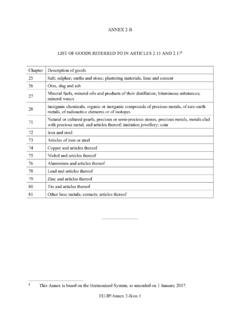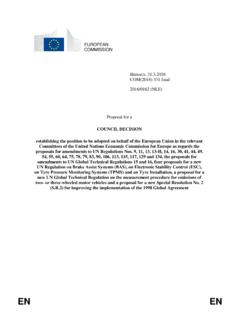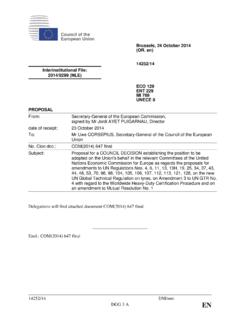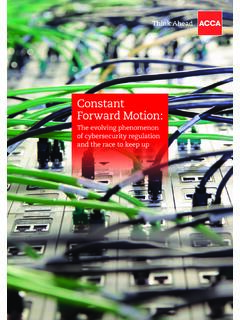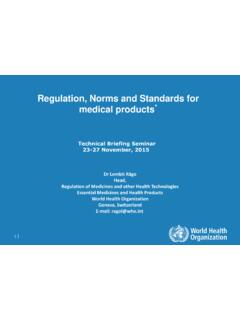Transcription of POLE SIDE IMPACT - UNECE Homepage
1 global technical regulation No. XX pole side IMPACT A. STATEMENT OF technical RATIONALE AND JUSTIFICATION 1. INTRODUCTION AND PROCEDURAL BACKGROUND At the 150th session of in March 2010, Australia introduced an informal document ( ), proposing the development of a global technical regulation (gtr) on pole side IMPACT . There were five key elements to this proposal, namely that: i) a high number of fatalities occurred in pole side impacts (that is, impacts with narrow objects such as telegraph poles, signposts and trees) and other side impacts in Australia and other countries; ii) there was wide variation between side and pole side crash tests both in regulation and voluntary standards.
2 Iii) there was wide variation between the crash dummies being used in the crash tests and concerns over their biofidelity, raising concerns about their effectiveness in predicting real world injury outcomes; iv) the development of the WorldSID, with its superior biofidelity, provided a unique opportunity to improve the international crash test regime for side impacts through development of gtr on pole side IMPACT , thereby improving the safety of motorists and minimising costs to consumers and industry; and v) a pole side IMPACT standard was likely to produce benefits for side impacts generally by driving improvements in head protection.
3 Requested the secretariat to distribute with an official symbol for consideration and vote at the June 2010 session. It was agreed to transmit to GRSP to consider at its May 2010 session and to assess the need for an informal group. At its 47th session in May 2010, GRSP considered Australia s formal proposal (ECE/ ) together with a further informal paper (GRSP-47-28), which included a proposed task list (subsequently developed into terms of reference), and endorsed establishment of an informal group under the chairmanship of Australia, subject to the consent of At the 151st session of in June 2010, considered Australia s formal proposal and agreed to develop the gtr and to establish the Informal Group.
4 Also agreed that the initial tasks of the Informal Group should be to (i) confirm the safety need for a gtr in light of the increasing prevalence of electronic stability control in the vehicle fleet and (ii) simultaneously assess potential candidate crash test standards to be addressed by the proposed gtr. The proposal is included among the Proposals for developing gtrs, adopted by (ECE/TRANS/WP29 ). In subsequent major developments, at the 154th session of in June 2011, adopted the terms of reference of the informal group and its first progress report (ECE/ ).
5 At the 157th session of in June 2012, adopted the second progress report of the informal group, together with a change to the informal group s terms of reference to clearly provide for a second phase of gtr development to incorporate the WorldSID 5th percentile female (ECE/ ). At the 51st session of GRSP in May 2012, the informal group submitted an initial draft of part B of the gtr (GRSP-51-16). [further major procedural steps to be added as appropriate] In developing the gtr, the informal group has undertaken a significant program of work including: i) Review of previous work, particularly work undertaken on side IMPACT protection by: the International Harmonised Research (IHRA) side IMPACT Working Group; the European Enhanced Vehicle Safety Committee (EEVC); the Advanced Protection Systems (APROSYS) research program.
6 And the United States of America, including its Final Regulatory Analysis to amend Federal Motor Vehicle Standard (FMVSS 214) to add an oblique pole test, published in 2007; ii) Conduct of extensive primary research, including crash tests programs conducted by Australia and Canada (including jointly), the United States of America, France, Japan and the Republic of Korea. This research has been the subject of detailed reporting in informal group meetings and is available on the informal group s website at < >; iii) Consideration of work by the informal group on the harmonization of side IMPACT dummies (see Section 4 below for more detail); and iv) Commissioning of research, through Australia, by the Monash University Accident Research Centre on the safety need, effectiveness and benefits and costs of the gtr1.
7 [this report is currently in draft; will be finalised upon receipt of IG comments] 2. THE SAFETY CONCERN The passive safety countermeasures expected to be used in vehicles to meet the requirements of the pole side IMPACT gtr (most likely side curtain airbags and thorax airbags) are likely to reduce injury risk in pole side IMPACT crashes as well as other side IMPACT crashes, including high severity vehicle-to-vehicle side IMPACT crashes and/or where head injury risks not simulated by current regulatory barrier tests occur as a result of geometric incompatibility between vehicles.
8 It was recognised in framing the informal group s terms of reference that there may also be benefits in rollover crashes. As a primary task, the informal group undertook a substantial amount of research on the number of occupant fatalities and serious injuries in pole side impacts, other side impacts and rollover crashes in contracting parties. Key data is presented in Table 1. 1 Fitzharris et al, Assessment of the need for, and the likely benefits of, enhanced side IMPACT protection in the form of a pole side IMPACT global technical Regulation, Monash University Accident Research Centre (2012).
9 This report was largely based on Australian data, but with the cooperation of the UK Department for Transport, the Transport Research Laboratory and BASt also included analysis of UK and German data. [Following Table 1 is indicative table only will be edited when data is finalised; the table will present a common year s data for all countries, either 2009 or 2010] Table 1: Fatalities and Injuries in pole side Impacts, Other side Impacts and Rollovers The data clearly demonstrates a major safety need. For example, in 2009, based on German, French, UK and Dutch figures, over 4,800 vehicle occupants were killed in side impacts in the EU (over 1,628 in pole side impacts; over 3,174 in other side impacts)2; 6,243 were killed in the US (1,371 in pole side impacts; 4, 872 in other side impacts); [XXX] were killed in Australia ([XXX in pole side impacts; XXX in other side impacts]) and 1,228 were killed in Korea (204 in pole side impacts; 1024 in other side impacts).
10 [scope to update figures to 2010?]. In the eight countries for which data is provided, in [2009] an average of over [5] percent of the road toll was killed in pole side impacts and over [12] percent of the road toll was killed in other side impacts, representing an average of [9] and [24] percent of vehicle occupant fatalities respectively. Assessment of the scale of serious injuries arising from pole side impacts and other side impacts is more difficult as definitions of serious injury have varied between the countries providing data and the figures provided in Table 1 should accordingly be treated with caution.

